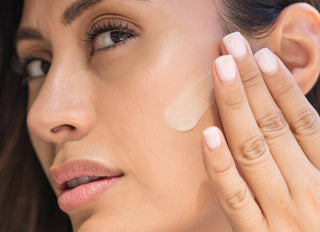It’s a tale as old as time. Everyone has an experience with retinol whether it was prescribed or tried over the counter. We’re all experts and we know to ask what percentage (when in actuality, that doesn’t matter as much as we thought it did) and we know to ask what kind of retinol. Due to its potency and effectiveness, this ingredient (both in prescription and over the counter form) isn’t going anywhere, so next time you’re caught in a retinol debate, impress them with your prowess. P.S. We won’t tell if you take the credit.
Back up, what does retinol do for my skin?
Retinol, a multi-talented skincare hero, is lauded by dermatologists, estheticians, and beauty experts because of its proven ability to reduce wrinkles, increase blood flow in skin (see buzzword “microcirculation”), fight acne, increase cellular turnover, boost collagen, and even skin tone. In other words, it’s an ingredient that truly does it all. If your shelf was going to have one product for the rest of its life, it should contain retinol.
Is prescription retinol better? What is the difference between prescription and non-prescription retinol?
Prescription retinol
Prescription retinol—called retinoic acid or more commonly known as tretinoin or Retin-A—is the purest, most active form of Vitamin A.
Pro: Prescription strength retinol is its most powerful form, which means the results are undeniable and uber effective.
Con: It can take a while to see visible results, even though it’s highly potent. And because of its potency, it usually triggers irritation—manifested via red, flaky, dry, patchy skin—before you’re able to fully acclimate (plus, we can’t use retinol around thin-skinned areas such as the lips and eye area). This sensitization makes it challenging to consistently use prescription strength retinol because skin can’t seamlessly adapt. For example, let’s say you start using Retin-A and notice your skin is inflamed. You then stop using it for a few days and pick it back up again when skin calms down, but eventually skin starts flaring up yet again. How do we break the cycle?
Another major con for most is the investment. Most insurance companies only cover retinol prescriptions as a drug to treat acne, and even then you have to be a certain age under most plans to get the prescription full comped. What about those of us looking to derive the other various benefits- fixing skin texture, evening out skin tone, rewinding signs of fine lines and wrinkles? When insurance can’t absorb the fees, a single tube of retinoic acid can cost upwards of $200 each (on top of the visit to the dermatologist). Woof.
Over-the-counter (OTC) retinol
OTC retinols come in various forms, including retinyl derivatives and retinal. These types are gentler but not as powerful, as they first need to convert to retinoic acid (the kind in prescription retinol) before effecting change in the skin. It’s important to know, all forms of retinol eventually end up as retinoic acid.
Pro: Just because an over-the-counter retinol product doesn’t come straight from the dermatologist doesn’t mean it’s ineffective. You can still reap the same benefits of prescription retinol in OTC products, it just depends on the type of retinol being incorporated. If you use an OTC skincare product with the right active levels of Vitamin A, you’re golden. Skin can reap the amazing benefits of retinol without the side effects and expensive prescription costs.
Con: Many OTC retinol products don’t contain nearly enough retinol to be effective once it is finally converted to retinoic acid in the skin. Conversely, many include too much retinol, still causing inflammation and irritation within the skin.
The fix?
The key is to titrate the concentration of retinol/retinyl palmitate giving skin a chance to adapt and graduate to the next level. It’s like school, what we learn in one grade equips us for the next. If we jump from first to 12th grade, we’d be severely lacking in preparation.
How do I know if I’m getting real retinol?
Retinol in its natural raw form is bright yellow, so checking the color of your OTC is a fantastic indicator to confirm the concentration. The deeper the yellow, the more retinol you’re getting.
What's the big difference between prescription retinol and OTC?
Why is retinol important?
To answer this question, the first thing to remember is “retinol” is just one of many types of Vitamin A—there’s also retinyl, retinal, and retinoic acid. The beauty industry simply uses the term “retinol” to describe them all.
Prescription “retinol” is technically retinoic acid. You’ve probably heard it referred to as tretinoin or Retin-A.
OTC retinol legally cannot contain retinoic acid. All OTC retinol serums or creams contain retinol, retinyl, retinal, or a blend of retinol and retinyl. All these OTC forms of retinol must break down and eventually convert into retinoic acid. (Retinoic acid is 20 times more potent than retinol. Thus .05% retinoic acid is roughly equivalent to 1% retinol.)
There’s also a new member to the retinol mix: conjugated retinoids, an emerging class of Vitamin A that do not cause the common side effects of red, scaly skin seen with retinyl esters, retinols, retinals, and retinoic acid. Conjugated retinoids reduce the appearance of wrinkles, hyperpigmentation spots, and uneven skin—without the irritation (our R45 The Reversal contains a blend called TriGlo™). This means individuals with sensitive skin can easily integrate this type of retinol into their routine with zero side effects. People can also use this type of way more frequently, even daily, getting the same long-term benefits as prescription strength retinol.






